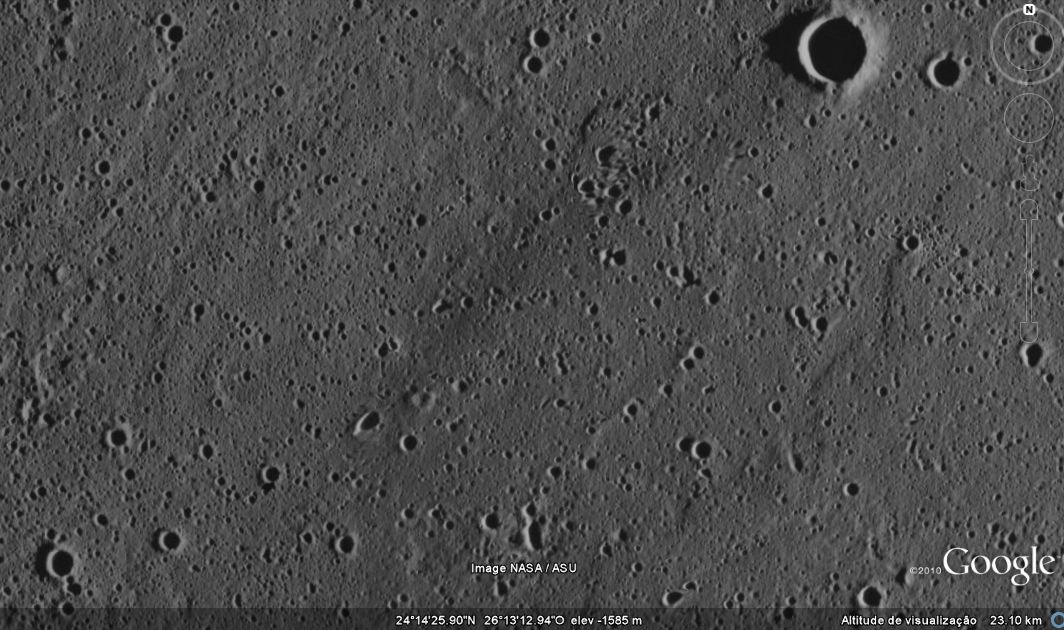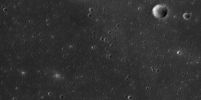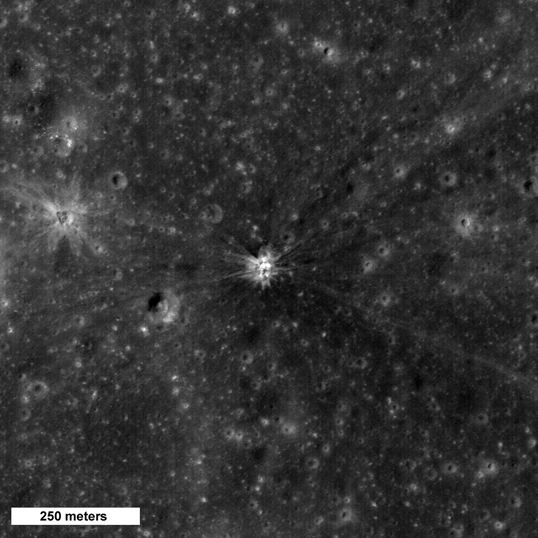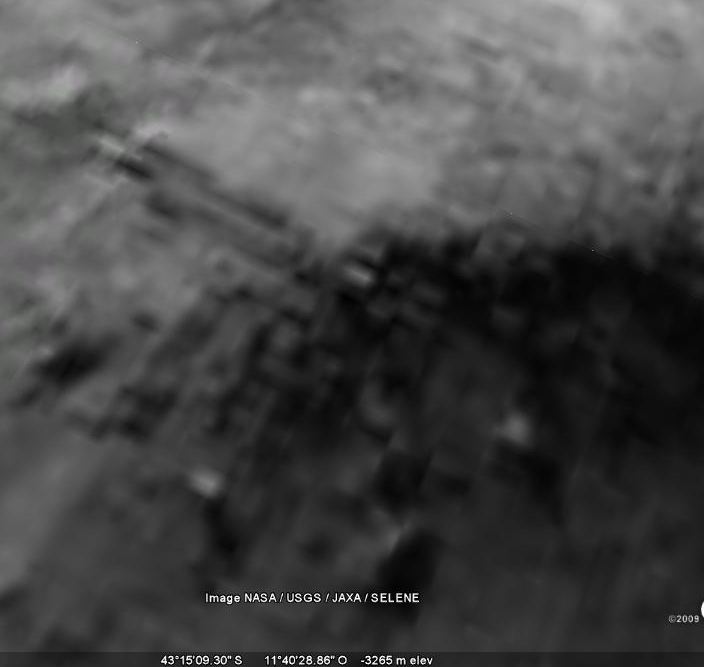It looks like you're using an Ad Blocker.
Please white-list or disable AboveTopSecret.com in your ad-blocking tool.
Thank you.
Some features of ATS will be disabled while you continue to use an ad-blocker.
share:
Originally posted by strafgod
Im not going to hold my breath on someone finding anything. Why would any alien race see our moon as a place of interest out of all the other places in the solar system? im not knocking the idea of searching the moon, it never hurt to look.
Posted Via ATS Mobile: m.abovetopsecret.com
Umm, well...
Considering earth is the only planet with life on it in our solar system that makes the moon an ideal spot to "watch" from so to speak, kind of like setting up an OP observation post on a safari trip
reply to post by watchdog8110
I couldn't find any photo from LROC, there's one that shows an area slightly to the northeast, but it doesn't show the "warped" area.
That "warped" area is not the only one, there's at least another one closer to that bigger crater near the top of the following image from Google.
(You have to scroll to the right to see the other "warped" area.

This is an image Kaguya/Selene that shows that area, with no "warped" areas anywhere.
(The image is too big to fit the thread, so I will only post a thumbnail, just click on it)

I couldn't find any photo from LROC, there's one that shows an area slightly to the northeast, but it doesn't show the "warped" area.
That "warped" area is not the only one, there's at least another one closer to that bigger crater near the top of the following image from Google.
(You have to scroll to the right to see the other "warped" area.

This is an image Kaguya/Selene that shows that area, with no "warped" areas anywhere.
(The image is too big to fit the thread, so I will only post a thumbnail, just click on it)

reply to post by ArMaP
What the heck ? There has to be something if they are going to use it as reference to a specific area , thats dang odd .
Was looking over the Jaxa image and this popped out as unusual .

What the heck ? There has to be something if they are going to use it as reference to a specific area , thats dang odd .
Was looking over the Jaxa image and this popped out as unusual .

Sorry, I don't understand what you mean by that, could you please rephrase it?
Originally posted by watchdog8110
What the heck ? There has to be something if they are going to use it as reference to a specific area , thats dang odd .
reply to post by watchdog8110
That looks suspiciously like an S-IV B impact crater:

www.nasa.gov...
Was looking over the Jaxa image and this popped out as unusual .
That looks suspiciously like an S-IV B impact crater:

www.nasa.gov...
Originally posted by DJW001
This should also get your attention:
"Although there is only a tiny probability that alien technology would have left traces on the moon in the form of an artefact or surface modification of lunar features, this location has the virtue of being close,
In other words, we're probably not going to find anything, but it's cheap.
Like usual... you miss the point... :shk:
All the skeptics for YEARS have been telling us that hunting for anomalies is only pareidolia and there is nothing there but rocks... that NASA isn't hiding anything
Now the SCIENTISTS working DIRECTLY with those photos are saying that WE SHOULD BE LOOKING
edit on 30-12-2011 by zorgon because: (no reason given)
Originally posted by Illustronic
With a bit of help not from me, all of the images are accessible from the internet, none better than the LROC.
And it is those very LROC scientists that are making the statement that we should be LOOKING and recruiting people to hunt
I am beginning to have serious doubts about ATS being the cutting edge Moon conspiracy site
:shk:
Originally posted by Pervius
Who would create a +Billion dollar satellite for their country to send to the moon and only attach a $25 web cam attached to it?
A country who's space program is dictated by NASA of course :S
The NASA Representative in the Pacific Rim is based at the U.S. Embassy in Tokyo, Japan and is responsible for coordination of NASA programs and interests in Japan and other countries in the Asia Pacific Region. The NASA Representative works with regional aerospace officials on key programs and serves as a local point of contact for NASA meetings and travel in the region. There are three NASA officials working in Japan and two assistants. In addition to the NASA Representative, there is a NASA International Space Station Program Liaison at the JAXA Tsukuba Space Center and a NASA Scientist at the JAXA Institute for Space and Astronautical Science.
On his first day of visiting China, Administrator Griffin presents a picture montage with a flown American and Chinese flags to President and CEO, China Academy of Space Technology, Dr. Yuan Jiajun. Click for Full Resolution. Credit: NASA.
oiir.hq.nasa.gov...
The mission of the Office of International and Interagency Relations (OIIR) is to provide executive leadership and coordination for all NASA international activities and partnerships and for policy interactions between NASA and other U.S. Executive Branch offices and agencies. OIIR serves as the principal Agency liaison with the National Security Council, the Office of Science and Technology Policy, the Department of State, and the Department of Defense. OIIR also directs NASA’s international relations; negotiates cooperative and reimbursable agreements with foreign space partners; provides management oversight and staff support of NASA’s advisory committees, commissions and panels; and manages the NASA Export Control Program and foreign travel by NASA employees.
oiir.hq.nasa.gov...
OH and China too

edit on 30-12-2011 by zorgon because: (no reason
given)
Originally posted by zorgon
Originally posted by DJW001
This should also get your attention:
"Although there is only a tiny probability that alien technology would have left traces on the moon in the form of an artefact or surface modification of lunar features, this location has the virtue of being close,
In other words, we're probably not going to find anything, but it's cheap.
Like usual... you miss the point... :shk:
All the skeptics for YEARS have been telling us that hunting for anomalies is only pareidolia and there is nothing there but rocks... that NASA isn't hiding anything
Now the SCIENTISTS working DIRECTLY with those photos are saying that WE SHOULD BE LOOKING
And those scientists are saying the skeptics have been right so far. They obviously think the anomalies found to this point have only been pareidolia and there is nothing there but rocks, and that they know of nothing that NASA is hiding.
Otherwise, rather than these scientists saying...
...they would have instead been talking about the anomalies that they think look like signs of alien technology.
"Although there is only a tiny probability that alien technology would have left traces on the moon in the form of an artefact or surface modification of lunar features...
It sounds to me that these scientists don't think that any signs of alien technology have yet been found.
edit on 12/30/2011 by Soylent Green Is People because: (no reason given)
reply to post by zorgon
You've got that half right. NASA isn't hiding anything. It just so happens that most of the "anomalies" turn out to be film defects or pareidolia, but keep looking.
Because, as I have already pointed out, they are busy looking for other things. They are noting which craters overlap in order to piece together a relative timeline. They are comparing boulders in various wavelengths of light to determine which are local exfoliations and which are ejecta from distant craters. If they came across a perfectly formed "X," they would assume it was a natural formation and speculate about how it ties in with the lunar hex tectonics.
All the skeptics for YEARS have been telling us that hunting for anomalies is only pareidolia and there is nothing there but rocks... that NASA isn't hiding anything
You've got that half right. NASA isn't hiding anything. It just so happens that most of the "anomalies" turn out to be film defects or pareidolia, but keep looking.
Now the SCIENTISTS working DIRECTLY with those photos are saying that WE SHOULD BE LOOKING
Because, as I have already pointed out, they are busy looking for other things. They are noting which craters overlap in order to piece together a relative timeline. They are comparing boulders in various wavelengths of light to determine which are local exfoliations and which are ejecta from distant craters. If they came across a perfectly formed "X," they would assume it was a natural formation and speculate about how it ties in with the lunar hex tectonics.
Originally posted by ArMaP
Interesting, doesn't Paul Davies trust his ASU colleagues?
And Robert Wagner, responsible for "image evaluation and assessment" in the Lunar Reconnaissance Orbiter Science Operations Center? Doesn't he trust his own team, or does he know something that we do not?
...or does he know something that we do not?
I think I will go with that one and sign up as a volunteer. Likely to get better results that way than wasting time here
Whether or not anything will be found at this point is irrelevant... the fact that top NASA scientists with access to the best quality images that we have available) that we know of) have joined the side of those seeking is a VERY significant development.
I know YOU understand that but I bet a lot of other skeptics are squirming.
You also know that we sent a request to have LRO look at the Tsiolkovski Crater lobate anomaly and they granted that request very quickly... (Those were the moving rocks you worked so hard on)...
So if that team is now looking for what we are looking for, seems to me very likely they will send the satellite for a closer look at areas we find interesting
You will also recall that it was the head of that team that 'leaked' us the color Clementine images in Oct 2006 when he moved from Northwestern U to ASU
I had to go out of town just as this was released and just got back... so I didn't have time to follow up but I am back and I put my team on it before I left...
Originally posted by DJW001
You've got that half right. NASA isn't hiding anything. It just so happens that most of the "anomalies" turn out to be film defects or pareidolia, but keep looking.
Again you miss the key point...
Though the chances of finding the handiwork of long-gone aliens are exceptionally remote, scientists argue that a computerised search of lunar images, or a crowd-sourced analysis by amateur enthusiasts, would be cheap enough to justify given the importance of a potential discovery.
www.guardian.co.uk...
So in other words they will use US to hunt because we work for free
"a crowd-sourced analysis by amateur enthusiasts, would be cheap enough to justify given the importance of a potential discovery"
So while the ATS skeptics and trolls still scream "Its only blurry rocks" the very scientists skeptics claim are to busy to even look are beginning to take it seriously.
but keep looking.
I intend to... but it won't be here
Originally posted by zorgon
Originally posted by Illustronic
With a bit of help not from me, all of the images are accessible from the internet, none better than the LROC.
And it is those very LROC scientists that are making the statement that we should be LOOKING and recruiting people to hunt
Paul Davies is not an "LROC scientist". He is a professor and director of the Beyond Center.
beyond.asu.edu...
www.lroc.asu.edu...
Robert Wagner is not an "LROC scientist". He is a "research technician". Interchangeable with "lab assistant". A cool job but it does not really qualify one as a scientist.
www.lroc.asu.edu...
"Cutting edge Moon conspiracy site." What does that mean? This proposal has nothing to do with a conspiracy but ATS has been useful. Not so much for finding "anomalies" but for finding image flaws and trying to figure out the difference between a hill and a crater.
edit on 12/30/2011 by Phage because: (no reason given)
reply to post by zorgon
I want to Join!
A Personal Gift to the JPL researchers from inside Tycho Crater.....

I want to Join!
A Personal Gift to the JPL researchers from inside Tycho Crater.....

Originally posted by Arken
reply to post by zorgon
I want to Join!
A Personal Gift to the JPL researchers from inside Tycho Crater.....
They don't accept applications from people who use Google Moon.
edit on 12/30/2011 by Phage because: (no reason given)
Originally posted by Phage
Originally posted by Arken
reply to post by zorgon
I want to Join!
A Personal Gift to the JPL researchers from inside Tycho Crater.....
They don't accept applications from people who use Google Moon.edit on 12/30/2011 by Phage because: (no reason given)
Why not?
Not so sure, my dear.... not so sure
edit on 30-12-2011 by Arken because: (no reason given)
reply to post by Arken
Because people who use Google Moon to find "anomalies" do not understand that overzooming an image does not provide any information. That it, in fact, destroys information.
Because people who use Google Moon to find "anomalies" do not understand that Google manipulates the original images in order to make them fit a curved surface and a digital elevation model. That this process introduces imaging artifacts which do not exist in the original images.
Because people who use Google Moon to find "anomalies" do not understand that overzooming an image does not provide any information. That it, in fact, destroys information.
Because people who use Google Moon to find "anomalies" do not understand that Google manipulates the original images in order to make them fit a curved surface and a digital elevation model. That this process introduces imaging artifacts which do not exist in the original images.
edit on
12/30/2011 by Phage because: (no reason given)
reply to post by Phage
While you are correct in your pointing out both Robert Wagners occupation and Paul Davis it should also be noted that they are still valuable sources in this proposal of getting the public involved with something of this nature;that is searching for anomalies or modifications to the lunar surface;'They have credibility too;
link; www.sciencedirect.com...
link; www.sciencedirect.com...
While you are correct in your pointing out both Robert Wagners occupation and Paul Davis it should also be noted that they are still valuable sources in this proposal of getting the public involved with something of this nature;that is searching for anomalies or modifications to the lunar surface;'They have credibility too;
Robert Wagner is an undergraduate student at Arizona State University majoring in Earth and Space Exploration. He works as a Research Technician in the Lunar Reconnaissance Orbiter Science Operations Center, where he is responsible for image evaluation and assessment. He has broad expertise in earth sciences and computing.
link; www.sciencedirect.com...
Paul Davies is Director of the Beyond Center for Fundamental Concepts in Science at Arizona State University. His research spans cosmology, astrobiology and theoretical physics. He has made important contributions to quantum field theory in curved spacetime, with applications to inflationary cosmology and black holes. He was among the first to champion the possibility that microbial life could be transferred between Mars and Earth in impact ejecta. He also runs a major cancer research program funded by the National Cancer Institute. He is the author of 28 books, including most recently The Eerie Silence: Renewing Our Search for Alien Intelligence.
link; www.sciencedirect.com...
Originally posted by Phage
reply to post by Arken
Because people who use Google Moon to find "anomalies" do not understand that overzooming an image does not provide any information. That it, in fact, destroys information.
Because people who use Google Moon to find "anomalies" do not understand that Google manipulates the original images in order to make them fit a curved surface and a digital elevation model. That this process introduces imaging artifacts which do not exist in the original images.edit on 12/30/2011 by Phage because: (no reason given)
This is your fairy tale from long long time my dear... a Fairy tale.
On Google there are real images like other. Who Manipulate the image? Google Team? IMPOSSIBLE. And The "zoom" cant distort a lot if there is an anomaly. Who manipulate the original images LPI, JPL? LROC ?
C'mon. stop with this silly argument.
edit on 30-12-2011 by Arken because: (no reason given)
reply to post by Phage
I was under the impression that the public or whoever where going to be using direct LRO lunar images and that source was the recommend sourcing images of the lunar surface;Google moon looks like it could through up imaginary data and also confuse rather than contribute or expand new findings of possible lunar surface modifications that seem or appear unnatural;
I was under the impression that the public or whoever where going to be using direct LRO lunar images and that source was the recommend sourcing images of the lunar surface;Google moon looks like it could through up imaginary data and also confuse rather than contribute or expand new findings of possible lunar surface modifications that seem or appear unnatural;
new topics
-
New Disney Star Wars Films Failing Test of Time?
Movies: 1 hours ago -
The Cost of True Discipleship—Count the Cost
Religion, Faith, And Theology: 6 hours ago -
population madness
New World Order: 8 hours ago -
Mass UAP events. DC. Machester Airport, UFOs over sub base in CT, Nuke bases.
Aliens and UFOs: 8 hours ago
top topics
-
Unidentified Flying Objects Over U.S. Military Bases in Northeast UK, as of roughly 11 a.m. CST.
Aliens and UFOs: 13 hours ago, 11 flags -
Thanking a rosemary plant
General Chit Chat: 12 hours ago, 6 flags -
Mass UAP events. DC. Machester Airport, UFOs over sub base in CT, Nuke bases.
Aliens and UFOs: 8 hours ago, 6 flags -
Holy Cow! Erm...Six Legged Turkey!!
World Sports: 17 hours ago, 2 flags -
population madness
New World Order: 8 hours ago, 2 flags -
The Cost of True Discipleship—Count the Cost
Religion, Faith, And Theology: 6 hours ago, 0 flags -
New Disney Star Wars Films Failing Test of Time?
Movies: 1 hours ago, 0 flags
active topics
-
population madness
New World Order • 10 • : Xtrozero -
V.P. Kamala Harris releases a video and nobody understands why
US Political Madness • 97 • : Xtrozero -
Unidentified Flying Objects Over U.S. Military Bases in Northeast UK, as of roughly 11 a.m. CST.
Aliens and UFOs • 26 • : Flyingclaydisk -
Thanking a rosemary plant
General Chit Chat • 5 • : Daniidoom -
Holy Cow! Erm...Six Legged Turkey!!
World Sports • 6 • : chiefsmom -
Results of the use of the Oreshnik missile system in Dnepropetrovsk
World War Three • 246 • : Dandandat3 -
New Disney Star Wars Films Failing Test of Time?
Movies • 3 • : Flyingclaydisk -
Vladimir Putin's speech at the meeting of the CSTO Collective Security Council
World War Three • 67 • : Oldcarpy2 -
The Cost of True Discipleship—Count the Cost
Religion, Faith, And Theology • 2 • : nugget1 -
Mass UAP events. DC. Machester Airport, UFOs over sub base in CT, Nuke bases.
Aliens and UFOs • 9 • : ArMaP

